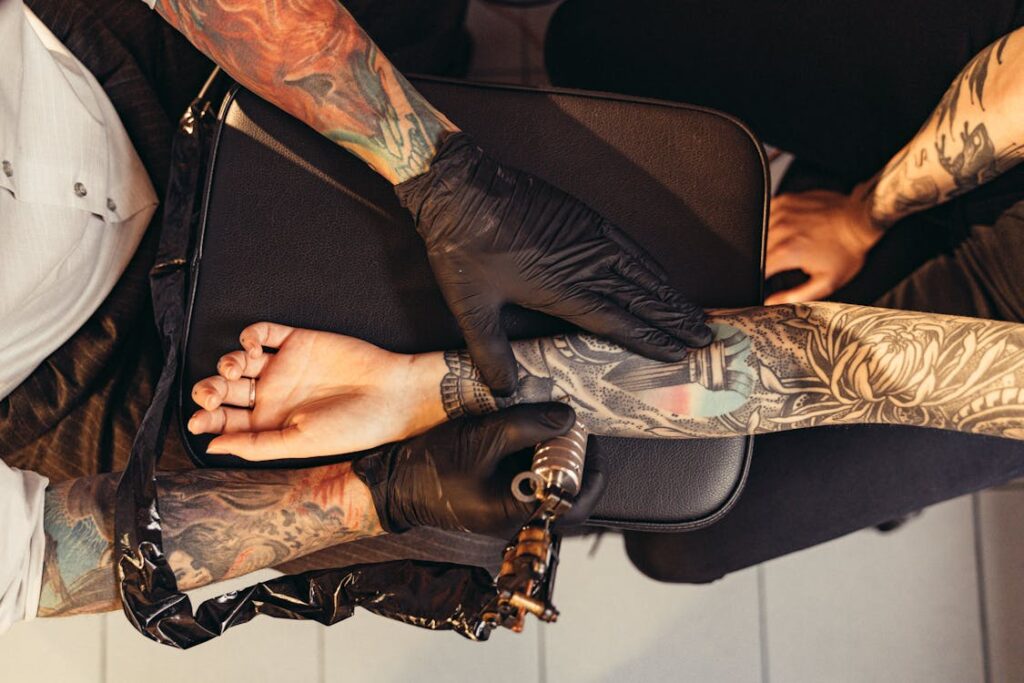Tattooing for beginners can be both exciting and overwhelming. If you’re interested in learning how to tattoo, you’re embarking on a creative journey that requires patience, skill, and the right tools. This guide will provide you with essential tips and tricks to help you get started and succeed in tattooing for beginners.
What You Need to Know About Tattooing for Beginners
Tattooing is not just an art form; it’s also a craft that demands precision, cleanliness, and practice. Whether you’re looking to create tattoos for yourself or pursue a career as a tattoo artist, it’s important to first understand the basics of tattooing for beginners.
To ensure you’re fully prepared, here are the key aspects to consider before you start tattooing.
Essential Tools for Tattooing for Beginners
Tattoo Machine The device that creates the tattoo by inserting ink into the skin.
Needles Used for injecting ink into the skin; different needle sizes are needed for various effects.
Inks Tattoo ink is specifically formulated for body art; using high-quality ink is essential.
Stencil Paper Used to outline your design on the skin before tattooing.
Gloves To ensure hygiene and avoid contamination during the tattoo process.
Having the right tools is one of the most crucial aspects of tattooing for beginners. Ensure you’re using professional-grade equipment to create clean, lasting tattoos.
Step-by-Step Guide to Tattooing for Beginners
-
Prepare Your Workspace
Ensure your workspace is clean and sterile. Tattooing for beginners requires you to pay close attention to hygiene, as this can affect the quality of your work and the safety of your clients. -
Practice on Synthetic Skin
Before tattooing on human skin, it’s a great idea to practice on synthetic skin or fruit like oranges to get a feel for the machine and needle. Tattooing for beginners involves learning the technique of controlling the machine and the depth of the needle. -
Outline the Design
Once you’re comfortable with the equipment, use a stencil to trace your design on the skin. This is a critical step, as it will guide your tattooing process. -
Start Tattooing
Begin tattooing by following the stencil design. Make sure to work in slow, controlled movements. Tattooing for beginners requires patience don’t rush through the process! -
Clean and Heal
Once your tattoo is complete, clean the area with an antiseptic and cover it with a bandage. Aftercare is crucial in ensuring that the tattoo heals properly.
Common Mistakes to Avoid When Tattooing for Beginners
Not Using Sterile Equipment Always use clean and sterilized tools to prevent infection.
Too Much Pressure Avoid pressing too hard on the skin; let the machine do the work.
Rushing the Process Take your time to ensure each line is perfect. Quality is better than speed.
Inconsistent Needle Depth Practice controlling general the depth of the needle for uniform lines and shading.
Avoiding these common mistakes is key to becoming proficient in tattooing for beginners. Remember, it’s important to focus on the details and stay patient.
Tattooing for Beginners: Tips for Mastering the Craft
-
Practice, Practice, Practice
The more you practice, the better you’ll get. Don’t expect perfection right away mistakes are part of the learning process. Keep honing your skills, whether on synthetic skin or under the supervision of a professional. -
Understand Skin and Ink
Different skin types require different techniques. Learn how various skin tones and textures affect the tattooing process. Additionally, understanding how the ink reacts to the skin is crucial for long-lasting tattoos. -
Stay Consistent
Consistency is vital in tattooing. Ensure that your lines are smooth, and your shading is even. A steady hand and a calm mind are key to producing high-quality tattoos.
FAQs About Tattooing for Beginners
1. How long does it take to learn tattooing?
It depends on your dedication and practice. It can take anywhere from a few months to a year to become proficient at tattooing for beginners. The more you practice, the faster you’ll improve.
2. Is tattooing hard to learn?
Tattooing is challenging, especially in the beginning. However, with the right guidance and consistent practice, it becomes easier over time. Tattooing for beginners can be tough, but it’s a rewarding skill to master.
3. Can I start tattooing without formal training?
While you can start learning on your own, formal training or apprenticing under a professional tattoo artist is recommended. This will help you understand the art better and learn proper safety practices.
4. How can I avoid mistakes when tattooing?
The best way to avoid mistakes is to practice and take your time. Don’t rush the process and always ensure your equipment is clean and in good condition. Tattooing for beginners can be tricky, but taking it slow is key to success.
Conclusion
Tattooing for beginners is a journey that requires dedication, patience, and the right tools. With the tips and tricks provided in this guide, you’ll be well on your way to mastering the basics of tattooing. Remember to stay consistent, practice regularly, and never stop learning. As you progress, you can refine your technique and create beautiful, lasting works of art.
For further reading and resources on tattooing, check out authoritative sources like Tattooing Basics and The Ultimate Tattoo Guide.
